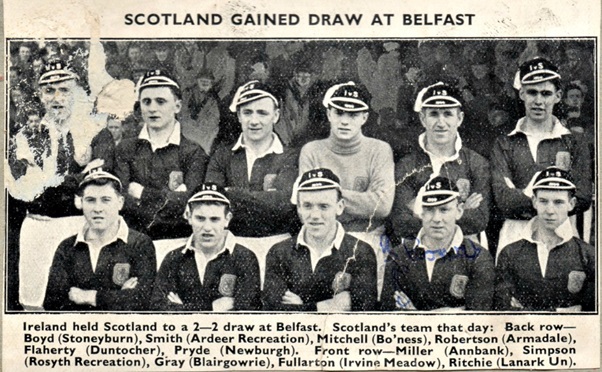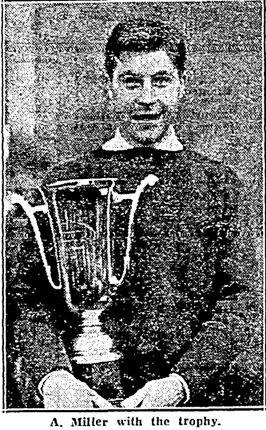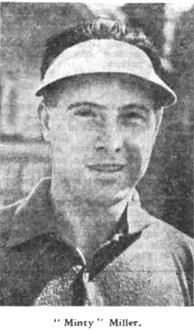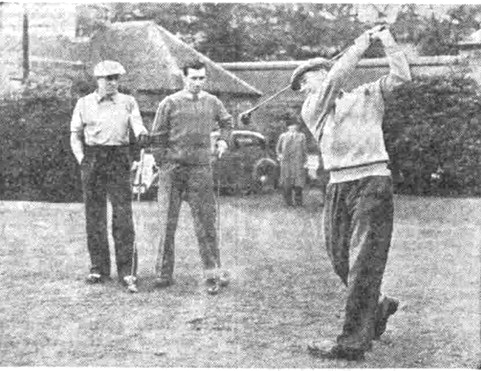He had just surprisingly, but deservedly, reached the next day’s final of the Scottish Boys’ Golf Championship but also had a ticket for the Scotland v England football international match to be played on the same day.
At Hampden Park Scotland needed a draw to retain the British Home International Championship and as a consequence travel to Brazil for the 1950 World Cup Finals. At North Berwick, Robert (“Bobby”) Brotherston of Dumfries awaited Andrew in the 36-hole final.
Andrew Clowes Miller (born 1932) was a pupil at Marr College, Troon, and was a five handicap golfer at Troon St Meddans. At five feet six inches tall and eleven stones in weight he was stockily built. At school he played both Rugby and Association Football but concentrated on the latter playing for Junior club Annbank United from the small mining village five miles outside Ayr in South Ayrshire. The club enjoyed a successful spell after the Second World War and scouts from Scottish and English League clubs would have been regular spectators as Annbank United reached the Sixth Round of the Scottish Junior Cup in the 1949/50 Season but were eliminated after two replays by Ardeer Recreation. Andrew’s performances had come to the notice of Rangers and he was provisionally signed by the Ibrox club.
He was also watched by the selectors for the Scottish Junior Football Association (SJFA) select team and became the third Annbank United player to be capped for Junior Scotland. The SJFA party left the Broomielaw in Glasgow aboard the Belfast ferry at 7:15 on the Friday evening to play against Ireland at Grosvenor Park, Belfast, on Saturday 18 February 1950. The kick off was scheduled for 11:00 so as not to clash with the Linfield versus Derry City match to be played in the city later that day. One newspaper reporter blamed the early kick-off on the disappointing crowd of 6,000.
There was a heavy pitch and Scotland took immediate advantage of playing with the strong wind in the first half. After just 1½ minutes Tommy Fullarton (Irvine Meadow XI) set Andrew free to make a cross that was headed home by Boyd (Stoneyburn). A few minutes later Tommy Fullarton cracked a shot that rebounded off the crossbar and it was met by Andrew who scored Scotland’s second after five minutes. In the second half Ireland seized the advantage with Irvine (75 minutes) and Minford (77 minutes) scoring to make the final result a 2:2 draw.
The Sunday Post reporter acknowledged, along with John Smith (Ardeer Recreation), Bobby Simpson (Rosyth Recreation) and Jim Ritchie (Lanark United), Andrew’s comparative youth but despite this and making the first and scoring the second of Scotland’s goals he summed up by saying “Miller was promising and disappointing in turn.”
In the Scotland team that day was goalkeeper Jocky Robertson (Armadale Thistle) who was only 5ft 5½ins tall but made up for his lack of height with agility. He won seven Junior Scotland caps in the early 1950’s and went Senior with Third Lanark and later played for Berwick Rangers. The Sunday Post reporter said “This will surely go down in the history books as ‘Robertson’s International’. The little Armadale ‘keeper’s second half display of clutching, punching and diverting of shots had the Belfast crowd in an alternating frenzy of enthusiasm and vexation. He alone accounted for Scotland breaking even at the finish”.
Of those other youngsters in the team John Smith went on to have a long league career with Stirling Albion and Dumbarton, Jim Ritchie later signed for St Mirren and Bobby Simpson was, like Andrew, a Rangers’ provisional signing later called up for the 1950/51 season. Jim Pryde (Newburgh) was also to be a Rangers player in 1950/51 and Valentine Flaherty (Duntocher Hibernian) was to sign for Alloa Athletic.
Tommy Fullarton was joined by Willie Mitchell (Bo’ness United) as the experienced Juniors in the team. Their paths had already crossed in the 1948 Junior Cup Final.
With his Hampden ticket now safely in the hands of his brother, he teed off at 9:15 in the first round of the 36-hole final. Andrew went on to win the Boys’ Championship by 3 and 1. The Scotsman said “Behind these figures that will occupy a bald line in the reference books is an astonishing pull up against heavy half-way odds, skill in the strokes that built up a dramatic recovery, and the praiseworthy courage that backed them.” In football parlance this was “a game of two halves”. Andrew was six holes down after the morning round but staged a remarkable comeback to win. The Scotsman correspondent paid tribute to his temperament and was no doubt referring to his football experience when he said Andrew was “crowd seasoned” as galleries of 500 and 1,000 followed his matches on Friday and Saturday respectively.
The newspapers also reported on the achievements of Robert Reid in the Championship. The young Fifer was to become Sir Bob Reid, who amongst many business appointments was Chief Executive of Shell and Chairman of British Rail. He had lost an arm in a childhood accident and despite a hectic professional life continued to be one of the best one-armed golfers in Britain.
Across Scotland at Hampden Park the outcome was disappointing. Scotland lost 0-1 to England and finished the British Home International Championship in second place. The British Championship also served as a World Cup Qualifying Group from which the top two teams would qualify for the finals in Brazil. However, the Scottish Football Association had decided that Scotland would only go to Brazil as reigning British Champions. No amount of canvassing from the Scottish players and others in the football world would make the SFA change its mind and Scotland stayed at home.
Although signed by Rangers, Andrew was able to play in the British Boys’ Open Championship at Royal Lytham and St Anne’s in August 1950. Andrew and his fellow golfers reversed the Hampden result with an emphatic 8½:3½ in the boys’ golf international against England staged on the Lancashire course immediately prior to the Championship. Four Scots, including Andrew, progressed to the Championship quarter-finals. However, Andrew was defeated 6 and 5 in the semi-final by the eventual winner John Glover (Campbell College, Belfast).
Each football club could enter a team of five with the Championship Cup going to the team with the three best scratch scores in aggregate. As Andrew stood on the last tee his team mates told him he could win the cup for the club for the very first time. He was bunkered on the 18th but recovered and rolled his putt next to the hole for a sure 4 and victory. Andrew was one of only three golfers in the field of over 100 to break 80. Andrew’s 79 together with Williamson (83) and Waddell (89) gave the Rangers team an aggregate score of 251, two strokes better than Kilmarnock, and the Championship Cup. The Killie team fielded trainer, former goalkeeper and fellow resident of Troon, Jock Brown. Jock was a scratch golfer and scored 77. Tommy Pearson, the Aberdeen winger, returned the best score of the day at 75. Both Jock and Tommy were competition golfers and competed in the Scottish Amateur Championship.
Andrew was a medical student at Glasgow University during his four full seasons at Ibrox and was Scottish Universities Golf Champion in 1953. As a footballer, Andrew made his Rangers debut on Wednesday 19 April 1950, just four days after winning the Scottish Boy’s Golf Championship, in a C Division match against Clyde A in front of a 10,000 Ibrox crowd. He went on to make 31 Reserve and Third XI appearances (4 goals) at Rangers.
He was released at the end of the 1953/54 season at his own request. Continuing his studies he signed for Alloa Athletic on 12 August 1954 and made two league cup appearances (0 goals) before being freed. He was re-instated to the Junior ranks in August 1955 when he re-joined Annbank United.
During his time in Senior football Andrew was unable to repeat the 1950 success in the annual footballers-golfers team event but excelled in the individual event with two victories and two more high placed finishes.
He had made his debut in the Scottish Amateur Championship in 1952 at Carnoustie. However, he failed to qualify for the final knock-out stages along with three other footballers - Jock Brown, Tommy Pearson and Alec Stott (Partick Thistle). Wallace Anderson (Falkirk) was football’s only qualifier. He fared better in the 1953 Championship at Prestwick knocking out three Americans before defeat to eventual finalist and American Walker Cup player Jim McHale. Andrew’s best performance was as losing finalist in the 1955 event at Muirfield. R Reid Jack, who went on to win the 1957 British Amateur Championship, won 2 and 1.
Andrew played in the British Amateur Championship on five occasions:
1952 (Prestwick) -5th Round
J B McHale (Saucon Valley, USA) won 5 and 4
1953 (Hoylake) - 7th Round (QF)
J W Draper (Innerleven) won by 1 hole
1954 (Muirfield) - 3rd Round
F Strafaci (Garden City, USA) won 3 and 1
1956 (Troon) - 2nd Round
G P Eyler (St Neots) won 2 and 1
1961 (Turnberry) - 2nd Round
Dr D M Marsh (Southport & Ainsdale) won by 1 hole.
In the 1961 Championship Andrew’s entry was under the name Dr A C Miller in the first Championship where entry was limited to golfers with a handicap of 3 or better and the overall number of competitors to 250. The 2nd Round tie involving the medical profession saw Andrew eliminated by Doctor David Marsh who went on to be in the winning Walker Cup team of 1971 at St Andrews.
Andrew also represented Scotland in the golf Home Internationals in 1954/55.
As a young, newly-qualified doctor Andrew was granted a short service commission in the Royal Army Medical Corps and in 1964 was granted a regular commission. He retired from the Army in 1970 as Major A C Miller M.B.,Ch.B. He was also awarded the Diploma in Tropical Medicine & Hygiene. Golf still played a part in his Army life as a member of the Army Officers Golf Society. He played in the Black Watch Challenge Medal competition in 1966 and tied for the silver medal (second place).
So, 1950 was a significant year in young Andrew’s sporting life. He was Scottish Boys’ Golf Champion and runner up in the British Boys’ Championship, he played for his country at both golf and football and led Rangers to the club’s only trophy in 1950/51.
And what about the nickname “Minty”? I have been unable to find its origins. However, my best guess is that it originates from Millar Pan Drops, a popular sweet at the time. These were made by Edinburgh confectioner John Millar & Sons. They were also known as “Scotch Mints”. John Miller, a forward with Dunfermline Athletic around the same time, shared the same nickname.




 RSS Feed
RSS Feed